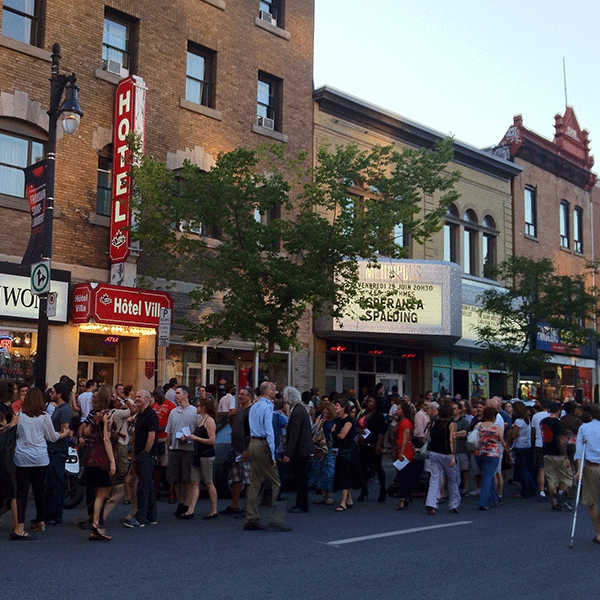Musicians on Musicians: The Gloaming is Dream-Music

Photo: The Gloaming, who perform at Michigan Theater on October 7, 2015. Photo by Feargal Ward.
There’s something special about music recommendations from friends. Think about your favorite bands, musicians, artists. How many did you find through someone you know? Did you discover your new favorite track by tapping a headphone-wearing someone and asking, “Hey, what are you listening to?”
This happens to us all the time at UMS offices, colleague to colleague. We’re also lucky because we can sometimes ask artists the same question.
We opened our season with Shara Worden (My Brightest Diamond), and then we found out she’s a fan of The Gloaming. Here’s what she has to say about the group:
When pianist/producer Thomas Bartlett [founding member of The Gloaming] tells me he is creating something new, I show up. Whatever Bartlett does, I know it will always be thought provoking, challenging, and beautiful; The Gloaming is just that.
Another artist we admire is Sam Amidon. He’s a Nonesuch Records artist who grew up in Vermont with childhood friend and frequent collaborator Thomas Bartlett. Amidon‘s latest release is Lily-O (Nonesuch, 2014), documenting his musical explorations with guitarist and composer Bill Frisell. The album was produced by Valgeir Sigurðsson (Björk, Bonnie “Prince” Billy, Feist). Mr. Amidon is a member of the Icelandic music collective/record label Bedroom Community. When asked to share with us what he personally admires in The Gloaming’s unique approach to contemporary Irish global music, Sam told us:
The Gloaming is dream-music. Not only do the songs and melodies and improvisations emerge and fade in a dreamlike manner, but the music itself seems to come from a trance-like state of deep listening that the five musicians practice. It is ensemble playing of the highest level in any genre. For me, it is also truly a dream made real, in the sense that as a kid, in my early teens, Martin’s fiddle playing was what I listened to while falling asleep and waking up, and in The Gloaming I now hearing him and the rest of the musicians surrounded by the piano playing of Thomas Bartlett, my childhood friend with whom I played and discovered music.
So we’re all listening to The Gloaming, and we can’t wait to host the group at Michigan Theater on October 7, 2015.
Have you got a band you love and which you discovered through a friend? Share your stories below.
UMS Playlist: A Touch of Minimalism
This post is a part of a series of playlists curated by artists, UMS Staff, and community. Check out more music here.

Dawn of Midi perform at Trinosophes in Detroit on January 31, 2015. Photo by Falkwyn de Goyeneche.
Minimalism can be extraordinarily beautiful. I’ve always been a believer of “less is more.” In the right hands, repetition, simplicity, and homogeneous textures of sound can envelop the listener in deeply meaningful and even spiritual ways.
In the playlist below, I’ve attempted to offer a sampling of minimalist techniques in a cross-section of genre and style, from pioneering tape experiments by Steve Reich (“It’s Gonna Rain,” ca. 1965) to minimalist 1990s electronica from the UK’s Richard D. James (aka Aphex Twin) and the Manchester duo Autechre (selected from their seminal 1995 LP Tri Repetae) to Dawn of Midi, a group with a mesmerizing, “electro-acoustic” sound that will perform at Trinosophes on January 31, 2015.
I have also included some surprises: Jason Moran and The Bandwagon’s cover of American-born innovator Conlon Nancarrow (who composed “Study No. 6” for player piano) and downtown New York experimental post-disco songwriter, cellist, and composer Arthur Russell (who died in 1992 at the age of 40 in relative obscurity).
This playlist represents merely a snapshot of some of my favorite minimalist moments. Hopefully it will encourage and inspire a deeper personal journey of discovery.
Please note: These fascinating (and intricate) soundscapes are best experienced on headphones.
What did you think about this playlist? Share your thoughts or song suggestions in the comments below.
UMS Playlist: Staff Picks by Mark Jacobson
This post is a part of a series of playlists curated by UMS staff, artists, and community. Check out more music here.

Photo: James Blake (performing in Ann Arbor on November 11, 2013).
Perhaps because, as a kid, I studied and practiced Western European classical music while primarily listening to 1960’s and ’70’s rock, blues, and jazz, I find myself with an affinity for a range of diverse styles, especially hybrid ones. I’m a firm believer that it’s not about the genre, but rather about the music itself. Here’s a bit of what I’ve been drawn to lately.
Listen on Spotify:
What did you think about this playlist? Share your thoughts or song suggestions in the comments below.
Esperanza Spalding Montréal International Jazz Festival
Our programming manager Mark Jacobson shared this photo with us. A crowd gathers outside of Esperanza Spalding’s performance this past summer at Montréal International Jazz Festival. We can’t wait to host her in Ann Arbor this weekend, Saturday, April 6.
We asked Esperanza Spalding what she’s been listening to lately. Check out her playlist.
James Blake: What the heck are they playing on stage?!?
Editor’s note: This piece is a collaboration between UMS programming intern Margaret Albrecht and senior programming manager Mark Jacobson.

Photo: James Blake (performing in Ann Arbor on November 11, 2013).
When the house lights dim, and strobe lights and color washes paint the stage, James Blake and his colleagues will play non-conventional instruments, sometimes in non-conventional ways.
Seeing the instruments in the dark will be tricky, so what instruments are they playing?
James Blake, a conservatory-trained pianist turned singer/songwriter and producer, provides the vocals for this project while performing on various keyboards and electronics. Blake can be heard building complex vocal harmonies in tandem with vocals he records live during the concert (via foot pedals to record and loop his voice), using nothing more than a Synth Prophet ’08, a few microphones, and his ears. During his set, Blake produces the same live effects that many of today’s popular artists spend hours sweating over in recording studios.
Rob McAndrews is credited in the program as providing guitar, synthesizer, and electronics. But what is remarkable is not the multitasking, but the seamless integration of these various instruments. One instrument rarely seen on stage, the Moog Taurus 3 analog synthesizer, is actually a fairly standard piece of equipment popularized by big name rock bands like Pink Floyd and Rush. The instrument is comprised of a series of pedals originally designed to be played by foot, which are similar to the pedals found on an organ. McAndrews however, plays the Taurus with his hands to create massive, low-end bass sounds. He also treats his guitar like a synthesizer, producing sounds atypical of a familiar electric rock guitar sound.
Ben Assister has an almost infinite array of sounds at his disposal through a combination of digital and traditional percussion. While most bands stick to a traditional, acoustic drum kit (typically comprised of variously sized cymbals, drums, and toms), Assister incorporates a digital drum pad into his minimalist kit so that he can rhythmically trigger pre-created electronic samples live, often while accompanying these samples on traditional drums and cymbals.
So now, when those lights dim, you’ll know what to expect: dramatic timbre changes, live vocal manipulations, looping, and harmonization, and, we hope, a concert experience you won’t soon forget.
For a preview of the music, take a listen to UMS Senior Programming Manager Mark Jacobson’s “Staff Picks” playlist, or Associate Manager of Community Engagement Mary Roeder’s “Electronic Music” playlist.
Or, take a look:



